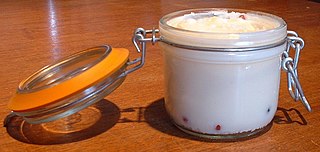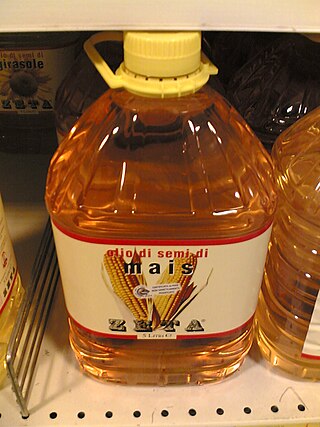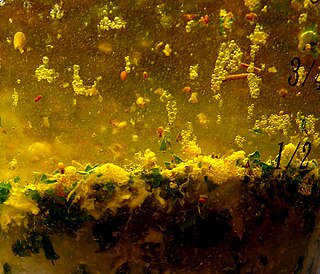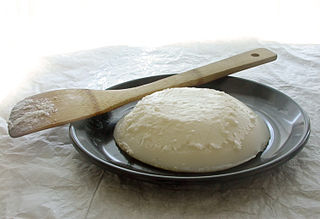Related Research Articles

In nutrition, biology, and chemistry, fat usually means any ester of fatty acids, or a mixture of such compounds, most commonly those that occur in living beings or in food.

A triglyceride is an ester derived from glycerol and three fatty acids. Triglycerides are the main constituents of body fat in humans and other vertebrates, as well as vegetable fat. They are also present in the blood to enable the bidirectional transference of adipose fat and blood glucose from the liver, and are a major component of human skin oils.

Biodiesel is a form of diesel fuel derived from plants or animals and consisting of long-chain fatty acid esters. It is typically made by chemically reacting lipids such as animal fat (tallow), soybean oil, or some other vegetable oil with an alcohol, producing a methyl, ethyl or propyl ester by the process of transesterification.
Transesterification is the process of exchanging the organic functional group R″ of an ester with the organic group R' of an alcohol. These reactions are often catalyzed by the addition of an acid or base catalyst. Strong acids catalyze the reaction by donating a proton to the carbonyl group, thus making it a more potent electrophile. Bases catalyze the reaction by removing a proton from the alcohol, thus making it more nucleophilic. The reaction can also be accomplished with the help of other enzymes, particularly lipases.

Vegetable oils, or vegetable fats, are oils extracted from seeds or from other parts of fruits. Like animal fats, vegetable fats are mixtures of triglycerides. Soybean oil, grape seed oil, and cocoa butter are examples of seed oils, or fats from seeds. Olive oil, palm oil, and rice bran oil are examples of fats from other parts of fruits. In common usage, vegetable oil may refer exclusively to vegetable fats which are liquid at room temperature. Vegetable oils are usually edible.

Tallow is a rendered form of beef or mutton suet, primarily made up of triglycerides.

Palmitic acid is a fatty acid with a 16-carbon chain. It is the most common saturated fatty acid found in animals, plants and microorganisms. Its chemical formula is CH3(CH2)14COOH, and its C:D is 16:0. It is a major component of the oil from the fruit of oil palms, making up to 44% of total fats. Meats, cheeses, butter, and other dairy products also contain palmitic acid, amounting to 50–60% of total fats. Palmitates are the salts and esters of palmitic acid. The palmitate anion is the observed form of palmitic acid at physiologic pH (7.4). Major sources of C16:0 are palm oil, palm kernel oil, coconut oil, and milk fat.
Biodiesel production is the process of producing the biofuel, biodiesel, through the chemical reactions of transesterification and esterification. This involves vegetable or animal fats and oils being reacted with short-chain alcohols. The alcohols used should be of low molecular weight. Ethanol is the most used because of its low cost, however, greater conversions into biodiesel can be reached using methanol. Although the transesterification reaction can be catalyzed by either acids or bases, the base-catalyzed reaction is more common. This path has lower reaction times and catalyst cost than those acid catalysis. However, alkaline catalysis has the disadvantage of high sensitivity to both water and free fatty acids present in the oils. August 10 is international biodiesel day

Yellow grease, also termed used cooking oil (UCO), used vegetable oil (UVO), recycled vegetable oil, or waste vegetable oil (WVO), is recovered from businesses and industry that use the oil for cooking.
In chemistry, acid value is a number used to quantify the acidity of a given chemical substance. It is the quantity of base, expressed as milligrams of KOH required to neutralize the acidic constituents in 1 gram of a sample.

Corn oil or maize oil (British) is oil extracted from the germ of corn (maize). Its main use is in cooking, where its high smoke point makes refined corn oil a valuable frying oil. It is also a key ingredient in some margarines. Corn oil is generally less expensive than most other types of vegetable oils.
Oleochemistry is the study of vegetable oils and animal oils and fats, and oleochemicals derived from these fats and oils. The resulting product can be called oleochemicals (from Latin: oleum "olive oil"). The major product of this industry is soap, approximately 8.9×106 tons of which were produced in 1990. Other major oleochemicals include fatty acids, fatty acid methyl esters, fatty alcohols and fatty amines. Glycerol is a side product of all of these processes. Intermediate chemical substances produced from these basic oleochemical substances include alcohol ethoxylates, alcohol sulfates, alcohol ether sulfates, quaternary ammonium salts, monoacylglycerols (MAG), diacylglycerols (DAG), structured triacylglycerols (TAG), sugar esters, and other oleochemical products.

Crocodile oil is extracted from the fatty tissues of crocodiles. Crocodile fat is a product of commercial farming, evident in Thailand. Historically, for centuries crocodile oil has been used by traditional practitioners across the globe, including Chinese Traditional Medicine, Southeast Asia, Ancient Egypt. Crocodile oil was found to be used since the 19th century for different purposes in different cultures. Due to the oil's components, its richness in monounsaturated and Polyunsaturated fats, it is today commonly used as ointment for treatment of skin conditions, skin structure enhancement, collagen deposition, and medicine for illnesses. In recent times, the use of crocodile oil has invited criticism from the use of crocodile oil as there is an increased demand for cruelty-free and vegan-friendly beauty products in consumers of today's society.

Chicken fat is fat obtained from chicken rendering and processing. Of the many animal-sourced substances, chicken fat is noted for being high in linoleic acid, an omega-6 fatty acid. Linoleic acid levels are between 17.9% and 22.8%. It is a common flavoring, additive or main component of chicken soup. It is often used in pet foods, and has been used in the production of biodiesel. One method of converting chicken fat into biodiesel is through a process called supercritical methanol treatment.
Winterization of oil is a process that uses a solvent and cold temperatures to separate lipids and other desired oil compounds from waxes. Winterization is a type of fractionation, the general process of separating the triglycerides found in fats and oils, using the difference in their melting points, solubility, and volatility.

Lard is a semi-solid white fat product obtained by rendering the fatty tissue of a pig. It is distinguished from tallow, a similar product derived from fat of cattle or sheep.
Single cell oil, also known as Microbial oil consists of the intracellular storage lipids, triacyglycerols. It is similar to vegetable oil, another biologically produced oil. They are produced by oleaginous microorganisms, which is the term for those bacteria, molds, algae and yeast, which can accumulate 20% to 80% lipids of their biomass. The accumulation of lipids take place by the end of logarithmic phase and continues during station phase until carbon source begins to reduce with nutrition limitation.
A sophorolipid is a surface-active glycolipid compound that can be synthesized by a selected number of non-pathogenic yeast species. They are potential bio-surfactants due to their biodegradability and low eco-toxicity.

Cooking oil is a plant or animal liquid fat used in frying, baking, and other types of cooking. Oil allows higher cooking temperatures than water, making cooking faster and more flavorful, while likewise distributing heat, reducing burning and uneven cooking. It sometimes imparts its own flavor. Cooking oil is also used in food preparation and flavoring not involving heat, such as salad dressings and bread dips.
Horse ointment, known as horse oil and horse fat, is a topical formulation derived from subcutaneous fat of horses. With its thick and highly viscous properties, horse ointment is intended for topical use on human skin and mucous membranes to provide moisturization and boost the restoration of damaged skin. Horse ointment preparations was traditionally used in ancient China for the treatment of qi deficiency, haemorrhoids, burns and xeroderma. Due to a high proportion of fatty acids in horse ointment, which are similar to human skin fat, it can effectively penetrate through the skin surface. Nowadays, it is commonly applied to skin for the purpose of soothing redness and irritation. It is considered a natural skincare product with low risks of sensitization and irritation and is safe for people of all ages, including infants and seniors.
References
- ↑ Srividya Ayalasomayajula, Ramalingam Subramaniam, August Gallo, Stephen Dufreche, Mark Zappi, and Rakesh Bajpai. Potential of Alligator Fat as Source of Lipids for Biodiesel Production. Publication Date (Web): July 15, 2011
- ↑ The New York Times. Sept 14, 2011
- ↑ Watt, George. A Dictionary of the Economic Products of India, Volume 2, Calcutta 1889, p. 592. Accessed on 24.1.2017 at https://books.google.com/books?id=iCdOAgAAQBAJ
- ↑ Anonymous. “Nile Crocodile”. Accessed on 24.1.2017 at http://repcillinpure.co.uk/crocodile/ Archived 2017-02-02 at the Wayback Machine .
- ↑ “Observations on Geophagy”, in The Southern Medical and Surgical Journal, Volume 1, 1845, p. 425. Accessed on 24.1.2017 at https://books.google.com/books?id=Ds9XAAAAMAAJ
- ↑ Pereira, Jonathan. The Elements of Materia Medica: Vegetable and animal materia medica, II, p. 2, London 1840. Accessed on 24.1.2017 at https://books.google.com/books?id=Sn5BAQAAMAAJ